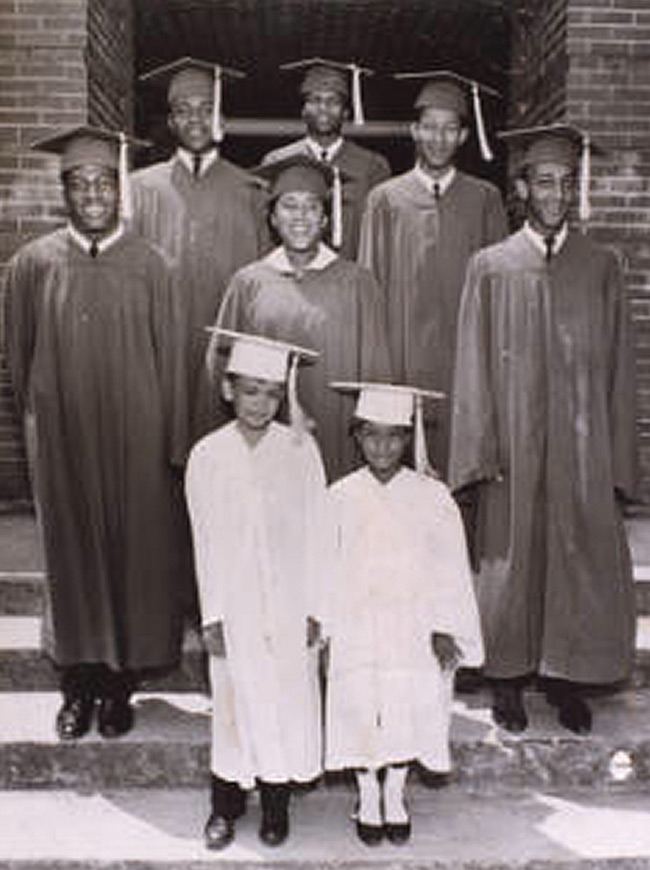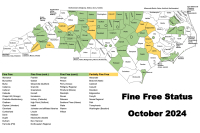Integration and the disappearance of Black teachers
 In an undated photograph developed from film brought to George Dexter Sherrill’s Waynesville studio for developing in the early 1900s, an African American man leans on a school bus. Hunter Library, Western Carolina University photo
In an undated photograph developed from film brought to George Dexter Sherrill’s Waynesville studio for developing in the early 1900s, an African American man leans on a school bus. Hunter Library, Western Carolina University photo
For Lin Forney, the end of fourth grade was the end of an era.
The year was 1963, and the world was changing. Nine years earlier, the U.S. Supreme Court’s landmark Brown vs. Board of Education decision struck down the “separate-but-equal” precedent that allowed racial segregation in schools, and the Civil Rights movement was spurring change — or at least talk of it — in communities across the South. Now, that change was coming home to Haywood County. The schools were desegregating.
‘One big community’
Before integration, Forney attended the all-Black Pigeon Street School, which now houses the Pigeon Community Multicultural Development Center, of which Forney is executive director. Her teachers and classmates were also her neighbors in the close-knit community that was her world. She loved it.
“It was just one big community whether you were in school or at church or at home,” she said. “Your path crossed with all the people in the community. If you were in trouble, your parents heard it faster than you could get home to try to dispute anything.”
The school was small and underfunded, with only three teachers for the couple dozen kids enrolled in grades one through six. Each year, students had to sign their names on the inside cover of their “new” textbooks. Forney remembers how the covers were always full of the names of kids they’d never met, white kids whose books had made their way to the Black school after years of use.
But Forney still loved the school — the community she felt with her classmates; the way the teachers invested in her, believed in her. In her memory, they were always willing to do whatever it took to make sure that the kids understood their lessons, even if it meant staying after school.
Related Items
In fifth grade, everything changed. Forney went to the formerly all-white Central Elementary School, but even though the rest of her Pigeon School classmates were there too, she rarely saw them. They were all in different classes.
Except for one substitute teacher in high school, Forney never had a Black teacher again.
“I know that people thought that integration was better for everybody as a whole, but to be quite honest, I don’t think it was the best for Blacks,” she said. “I feel like we lost a lot in that changeover.”
Losing the role models she’d had in the Pigeon School’s teachers left a hole. It always seemed like the white teachers expected her to be less academically able, just by looking at her.
“I think I felt less than, just simply because I had no mentors right there to look at, to say, ‘We got this. You can do this,’” said Forney. “Encouragement wasn’t often given, and I think it’s just a fact that I didn’t feel that investment in my education by the white teachers.”

The Reynolds High School Class of 1962 poses for a photo. In the front row serving as “mascots” are Nicky Davis and an unnamed female student. In the front row are (from left) Stanley Gibbs, Betty Ruth Sheppard and Raymond J. Sheppard. In the back row are (from left) Henry Dorsey, Charles Vincent Thompson and Charles Simpson. Photo courtesy Haywood County Public Library History Collection for research and educational purposes
What about the teachers?
When political leaders in the Civil Rights Era talked about integration, they were mostly talking about putting Black students into classrooms within formerly all-white schools — not about welcoming white students into Black schools, or about melding the staffs of the then-separate educational systems. In most cases, the Black schools were shuttered or turned into support buildings.
According to a 2009 journal article in Ethnic and Racial Studies titled “The Impact of Desegregation on Black Teachers in the Metropolis, 1970-2000,” after the Brown vs. Board of Education decision 38,000 Black teachers and administrators in 21 Southern and bordering states lost their jobs.
“With integration, all they wanted to do was integrate the kids,” said Carrie Rogers, an associate professor in Western Carolina University’s School of Teaching and Learning. “They didn’t think about the teachers.”
It’s still a bit of a mystery how that played out locally. How many Black teachers were there in Western North Carolina prior to integration, and how many were offered jobs with the integrated school system? How many accepted those jobs, and how many kept them?
“No one knows,” said Rogers. “We know where the kids went. The teachers are harder to track down.”
The answers are hidden in paper Board of Education archives and library microfiche, and Rogers recently launched a research project aiming to uncover Jackson County’s local story.
Libba Feichter, now 81 years old, was in her early 20s when she began working as a traveling music teacher for Haywood County Schools, giving weekly lessons at many of the smaller elementary schools across the county. Pigeon School was one of them.
“James Bryant, who was the principal at the Pigeon School, was so good to work with and such a remarkable leader,” she recalls. Though she was the only one in the room who wasn’t Black, she always felt welcome.
Feichter visited Pigeon School for only a year before integration and continued to teach in the school system afterward. Black teachers were offered jobs in the county after their schools closed down, she said.
“They were not just dumped,” she said. “I can guarantee you that. A lot of them stayed.”
How long they stayed, though, is a different question. This all happened a long time ago, but Forney is rather certain that many Black teachers left the school system soon after integration.
Regardless, they certainly faced obstacles.
In a 2017 interview recorded for WCU’s Oral History Collection, Scotland native Norma Kimzey spoke of her friendship with Elsie Osborne, who taught the combined first/second grade class at Pigeon School and transferred to Hazelwood Elementary School after integration. In 1968, Kimzey taught first grade and Osborne taught second. Their grades took recess at the same time, and the two would chat while their students played. When the students lined up to go inside, Kimzey noticed that Osborne had fewer kids in her class, despite the fact that every other teacher was “loaded up.”
“One day we were all out on the playground, and these first graders that I had — they say everything and anything to you — and this little boy came up to me and he said, ‘My daddy said I’m not going in that lady’s class next year.’ And I thought, that’s why she doesn’t have a full load of kids,” Kimzey said.
Over the next three years Kimzey worked there, things changed. She began to notice more and more kids in Osborne’s classes. But she did not notice an increase in Black teachers. She recalls meeting only one other Black teacher while in Haywood County, a former Reynolds High School teacher named Wilbur Eggleston who taught at Pisgah High School.
Struggles with access
If Black teachers lost their jobs or stopped teaching, it likely wasn’t because they weren’t up to snuff with expectations at the formerly white schools. In fact, WCU History Professor Elizabeth McRae said that at the time of integration, Black teachers in North Carolina had a higher average level of educational attainment than their white counterparts. It’s hard to say exactly why this was the case, but McRae has some thoughts.
“In part, North Carolina had a pretty strong higher education system for African Americans as opposed to some other states,” she said. “And I think that teaching was a really good job, particularly in a segregated world where a lot of professional economic opportunities were closed off to Black women and men. In the Jim Crow era, education was a path to real economic security, and there was a deep value for education.”
It’s unknown how many of the teachers in Western North Carolina’s segregated schools came to the area originally. Rogers believes that many of them likely came from somewhere else, for the simple reason that in the local area there were woefully few opportunities for Black students to receive even a high school education, and none for college.
West of Asheville, Reynolds High School in Canton was the only standalone high school for Black students. While the Central Consolidated School in Sylva began offering high school classes in the 1940s, correspondence between Principal William Wade and state administrators indicate that situation was tenuous at best.
In a letter dated Feb. 2, 1938, Wade wrote N.C. Division of Negro Education Director Dr. N.C. Newbold to ask that the school be allowed to keep the five teachers currently on staff. At the time, the school enrolled only 106 students but served grades one through 10. Wade hoped to add eleventh grade classes the following year. It seems he was allowed to keep the teachers and add a grade, because in a letter dated April 3, 1949, Wade asked N.C. State Board of Education Chairman Hiden Ramsey for a sixth teacher so that students could receive a four-year high school education.
“There is an urgent need that we have six teachers so as to offer four years of high school to the students in these two counties,” he wrote. “Failing to do so causes 95 percent of them to stop school after fishing the tenth grade.”
Slow to integrate
Even after the Brown decision made segregation illegal, African Americans in North Carolina continued to contend with inferior educational access and facilities.
A Jan. 26, 1950 article in The Sylva Herald includes “indoor toilets” in the list of planned upgrades for the Black school at the time, and a series of letters between Jackson County Public Schools Superintendent Vernon Cope and Division of Negro Education Director G.H. Ferguson exchanged after the 1954 Brown decision indicate that four years later the upgrades still had not been made. In the exchange, Cope and Ferguson discuss whether the county should move forward with plans to build a new Black school or wait for integration. Cope and Ferguson concluded that due to the “tragic condition” of the present school, the county should build as soon as it was able.
The new building — the site of the current Jackson County Board of Education — opened in 1961 and served students for just a few years before integration finally came to Jackson County in 1964. Something similar happened in Haywood County. The original Pigeon School was on the opposite side of Oakdale Road from the present building, which opened in 1957.
In a 2015 WCU Oral History Collection interview, Mary Sue Casey — a Jackson County native and one of the few Black women to have taught in the school system — said that she doesn’t believe integration ever would have happened if it weren’t for the friendship that existed across racial lines between local football players.
“They would get together and play during the summer,” Casey said. “The way I understand it, one said to the other, ‘You should play with us instead of Webster.’ And they said, ‘OK, when does practice start?’ And they just showed up. The Black guys just showed up for practice, and the coach said, ‘You can only play here if you go to school here.’ And they said, ‘OK, where do we go to register?’ Not knowing what a big deal it was. When they were confronted with that, they had to deal with it in some way.”
Nearly 60 years have passed since then, and to most people alive today, segregated schools were only ever a reality in history books. But racial tensions still simmer, and the dearth of African American teachers is still evident in school systems across America. Despite the decades in the rearview, Forney still finds herself thinking less-than-fond thoughts about her experience on the front lines of integration.
“It was very traumatic for me, having that move and that change when it happened in my life,” she said. “I was a little bit upset and I am today, if I’m being honest, that I didn’t get to go to Reynolds High School. I looked forward to going to Reynolds.”













